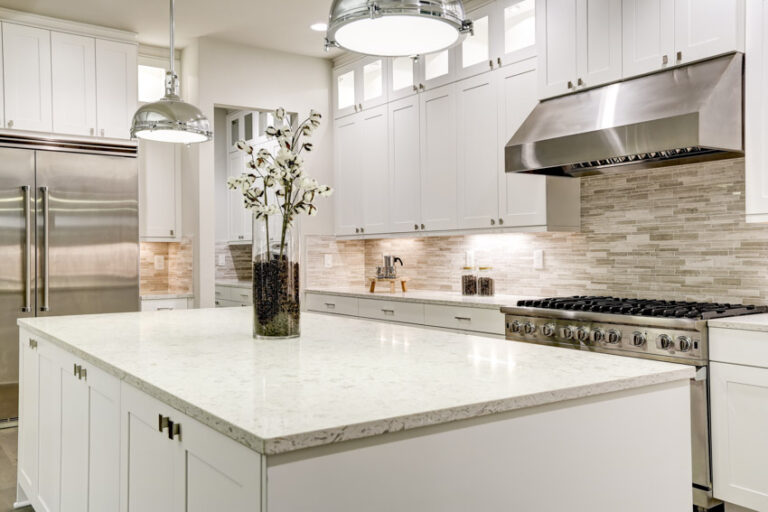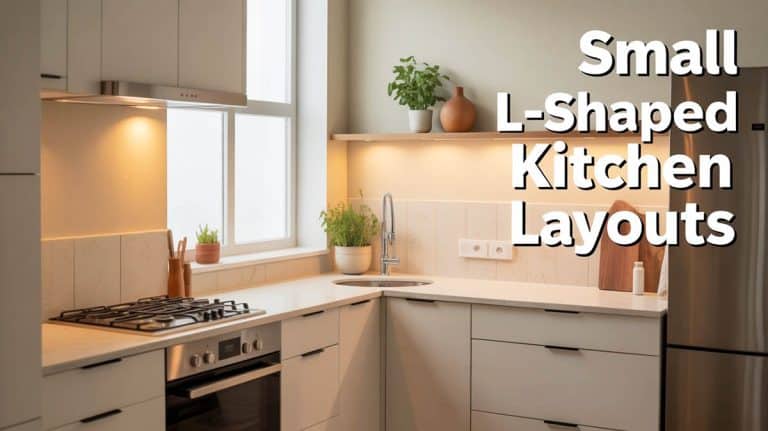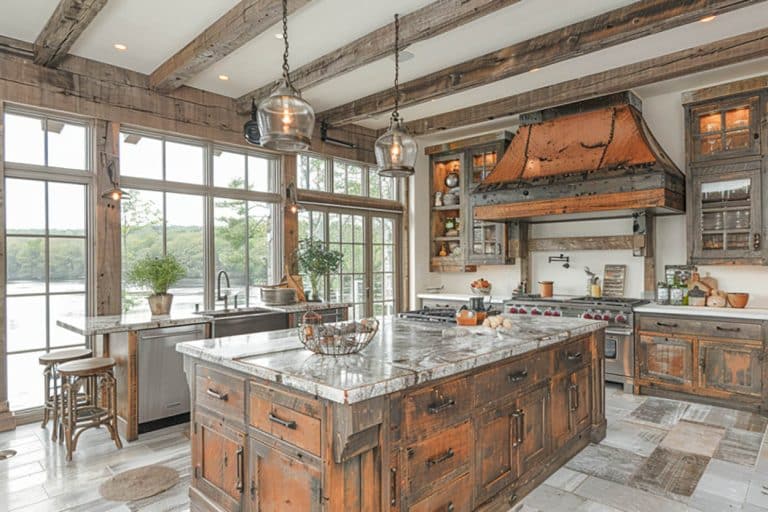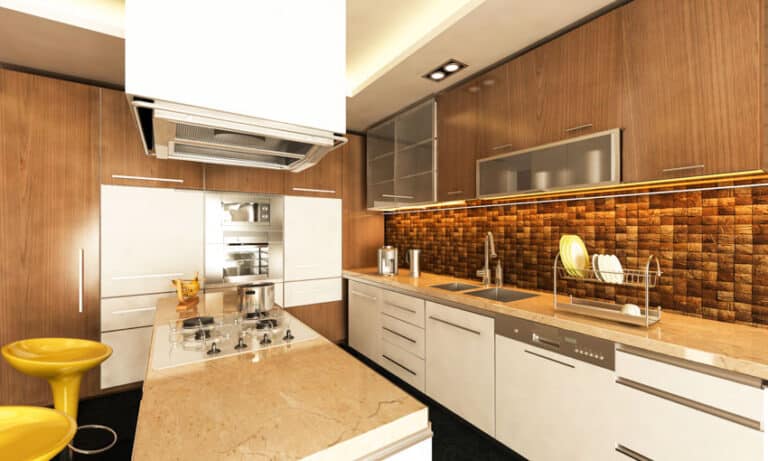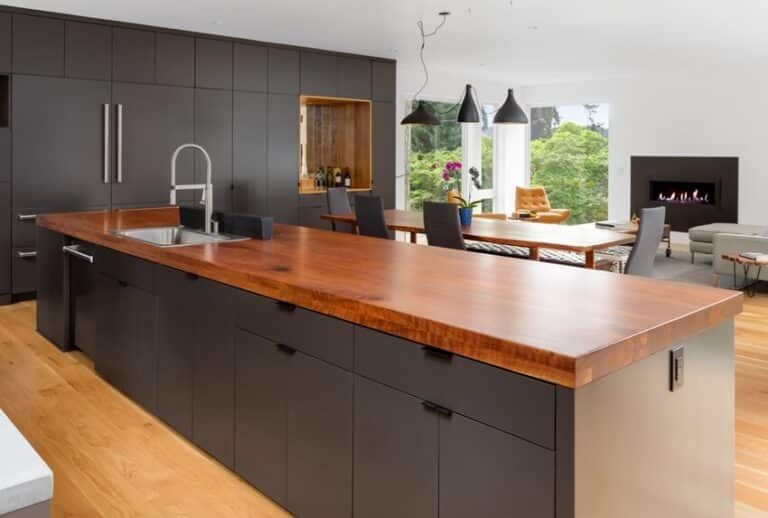Kitchen Appliance Placement Tips For a Family-Friendly Layout
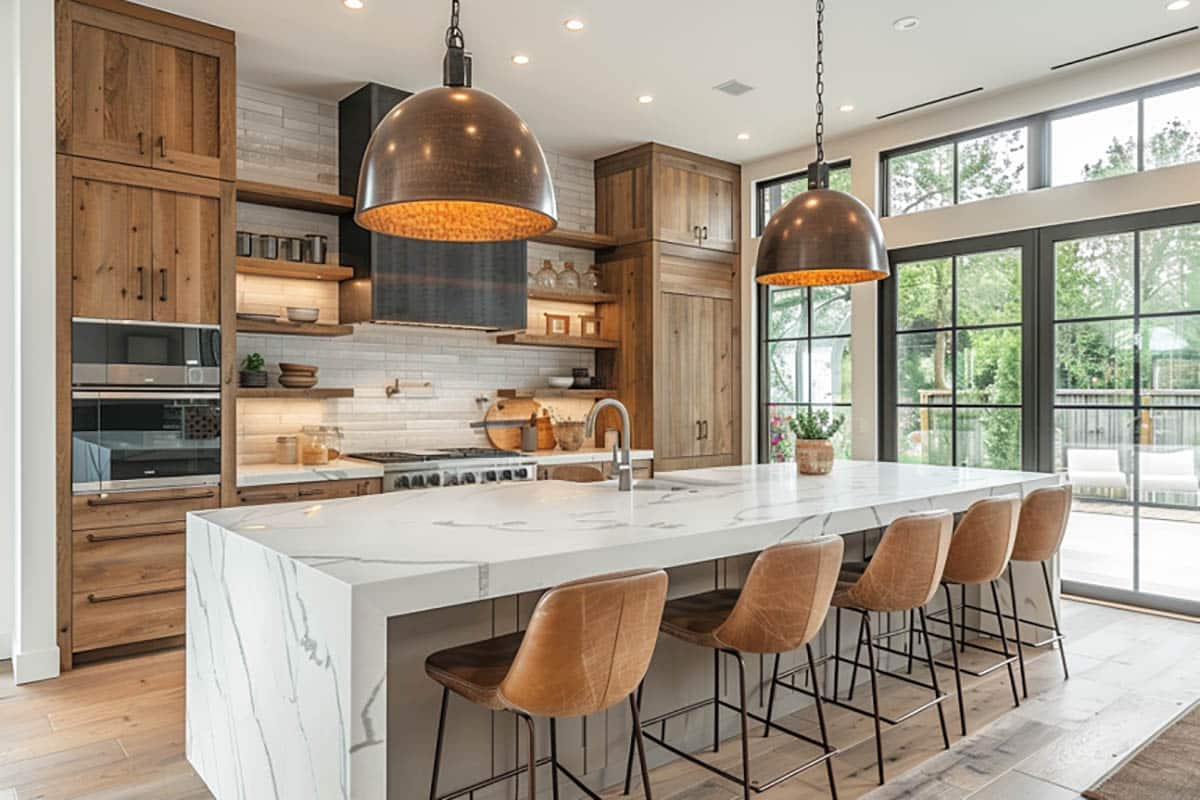
Let’s face it a poorly planned kitchen space can turn everyday meal prep into a disaster zone. A proper organized work triangle can make all the difference for functionality workflow. Using family-friendly kitchen appliance placement tips can make all the difference and look amazing at the same time. Let’s dig in to some of my go-to designer tips for creating the perfect layout.
Creating a Functional Kitchen Appliance Layout
There are three main areas in the kitchen – the sink with countertop space, fridge, and cooker. Creating a functional layout between these areas should ideally form an open triangle layout which provides a smooth flow of traffic and ensures the functionality and efficiency of your kitchen design plan.
An L-shaped kitchen is a great layout for incorporating the kitchen triangle rule where the essential functions of the sink, fridge, and cooker are within a few feet of each other. This type of layout clearly defines the cooking and cleaning zones as well as can even provide an open space for socializing. The L-shaped kitchen typically features the sink and stove on the same wall of the kitchen while the fridge together with the storage space and preparation area on the other side. Keeping the distance between the sink, stove, and fridge to a minimum provides a safe flow of movement around the kitchen.
A typical layout for small properties is the galley-type kitchen designed within a long and narrow space. The galley layout allows for a more efficient workflow throughout the work area by having two parallel walls with an aisle running down the middle of the kitchen. Here, the triangle kitchen rule in the placement of appliances is distributed between the two sides of the kitchen. The sink and stove are placed opposite each other and the fridge is usually on the same wall as the stove.
However, instead of walking across the hallway to transfer hot pans or boiling pots of water and dispose of unnecessary utensils; the sink and stove can be placed on the same wall provided that there is no less than 24″ or 60 cm distance between the two appliances.
Another popular kitchen design is the U-shaped layout where you find the sink usually under a window on top of the U while the fridge and stove are located on opposite sides. The U-shape is known as a versatile layout for a kitchen because it provides storage and countertop space on three walls. It can also be enhanced by incorporating a table in the center of the kitchen or an island for food preparation. For sufficient access and movement, the central minimum width of the kitchen area should be between 6 feet to 8 feet.
Tips For Placing Appliances
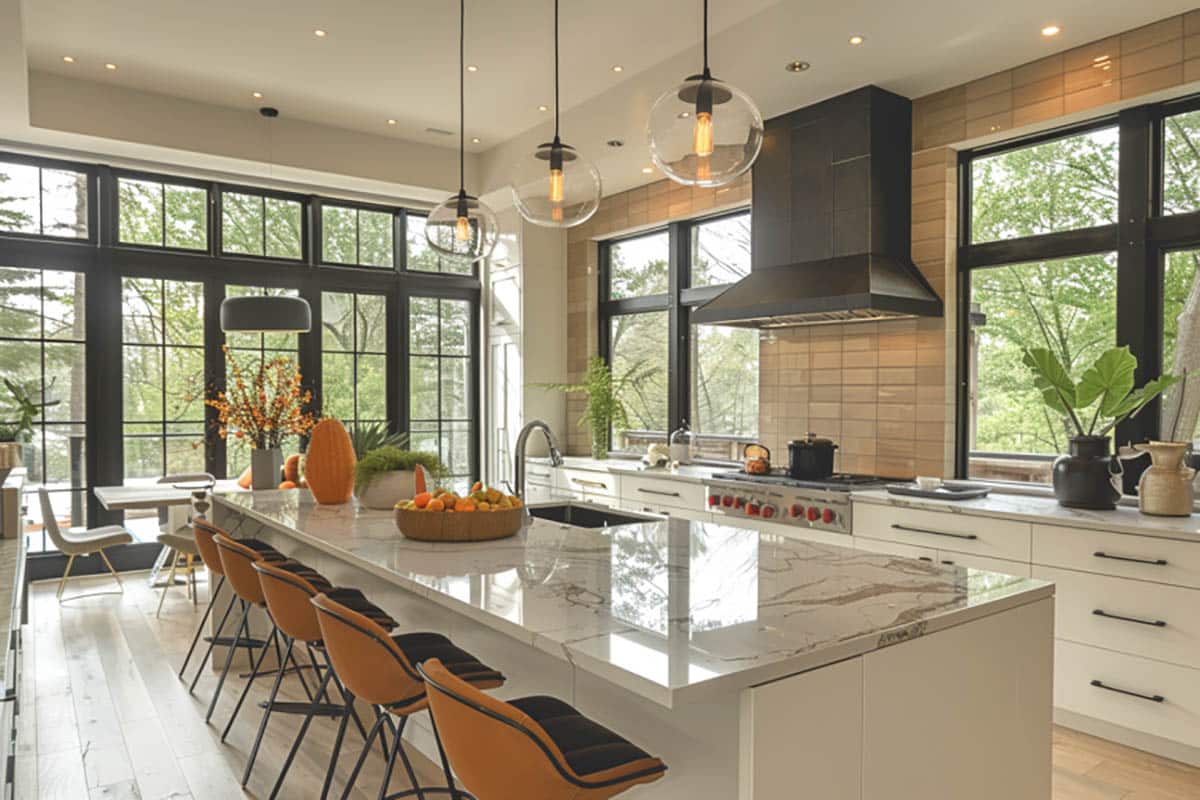
The refrigerator is often needed for quick snacks or refreshments, so position it near the entrance for easier access. Be mindful of which way the door swings out so it doesn’t block pathways through the aisle. For a streamlined look, consider a counter-depth model that doesn’t stick out too far.
Strategically place the dishwasher close to the sink to simplify loading and unloading. Check that there’s adequate clearance when the door is open so it’s not obstructing the workspace. For easier, ergonomic loading and unloading, think about raising it slightly or considering a model with adjustable rack heights.
Position the microwave at an accessible height based on who will use it most. For children old enough to safely use the microwave alone, install it at or just below standard counter height. It can be placed in an island if more room is needed. If planning to mount it overhead, make sure it’s low enough for shorter family members to comfortably reach, or consider a pull out step.
Be thoughtful about positioning the oven and stovetop. Place them away from major traffic paths in the kitchen to prevent accidents. If using a separate cooktop and wall oven, put the oven at eye level for safe access. Cooktops tend to be safest when controls are placed at the front.
Designate appliance storage areas to keep counters free of clutter. Pull-out shelves in lower cabinets are great for neatly tucking away heavier stand mixers, while an “appliance garage” hides the small appliance fleet when not in use.
Should space allow, stacked double ovens enable simultaneous cooking and provides extra oven space. Place at a comfortable height with main users in mind. Properly sized, positioned and powered range hoods clear cooking fumes and mitigate grease and odors. These are usually best installed 24-30 inches above the cooktop.
For quick clean-up, position trash and recycling bins in a lower cabinet near the prep zone or sink. A dual bin system allows for easy sorting. To keep the main kitchen clear of morning rush crowds, create a dedicated coffee station on a secondary surface away from major appliances.
Safety Considerations

A well-planned kitchen integrates safety considerations for kitchen appliances where the placement of appliances contributes much to the ease of access and provides optimized workflow and utilization of the space available.
The best place to have the stove is against a wall with enough counter space for food preparation. Installing a range hood directly above the stove with sufficient clearance and efficient airflow will help in capturing and eliminating cooking odors, steam, and grease from the air.
Install ovens and microwaves at the adult height to prevent accidental burns. And small wall ovens should be placed at least 14″ or 35 cm distance between the cooktops to prevent heat damage during cooking and ensure safety.
Place the refrigerator near the entrance for easy access and away from heat sources or make sure that there is enough space between the stove and the fridge for proper airflow and prevent heat transfer.
There should be enough outlets for all kitchen appliances and make sure that it has appropriate voltage to avoid overloading the electrical circuits. Other accessories like knife blocks and sharp utensils should be places in upper cabinets or use magnetic strips above counters for a kid-friendly space.
Kid-Friendly Features
The kitchen needs to meet the needs of all family members especially when there are children. It is important to choose easy-to-clean surface materials and resistant to stains. Round edges countertops and tables are more kid-friendly. Cabinets and drawers that are easily reached by children should have child-proof locks. To prevent accidents, installing slip-resistant flooring offers an extra safety feature around the kitchen area.
Getting kids involved in some kitchen tasks requires having a kitchen stool or step ladder for them to comfortably reach the work surface and get up close. Make this a fun experience for them by incorporating in the kitchen recycling bins that have lids and can seal for some extra sanitation.
As the kids get older, ensure they are provided with an easy-to-reach cupboard for their cups, plates, and placemats as well as a dedicated low shelf in the pantry where they can easily get their cereals and other snacks. Another great feature to consider is fitting a space-saving fridge or under-counter fridge outside the work triangle where it can be stocked with juice, water, milk, and other food options that kids can access for an after-school snack.
For the kitchen cabinetry, it is better to choose wood or laminates for drawer fronts and cabinet doors in eggshell or gloss finish because it won’t show little fingermarks plus it can be easily cleaned. It is also best to have white or faux stainless-steel appliances for easy cleaning.
Multi-Use Spaces
A kid-friendly kitchen layout needs a safe and comfortable working environment that accommodates everyone. Integrating workspaces at different heights to accommodate various tasks in the kitchen will make work easier and safer.
An open or pull-out shelf will be a good place dedicated to these appliances to have a well-functioning space in the kitchen.
If the kitchen is large enough to accommodate a kitchen island, add a seating area to be a study area where kids can do homework or a work area for parents. A kitchen island can also serve as a preparation area for meals and baking preparations. It can also be used for cooking by installing a cooktop or sink for easy cleaning up.
Storage Solutions
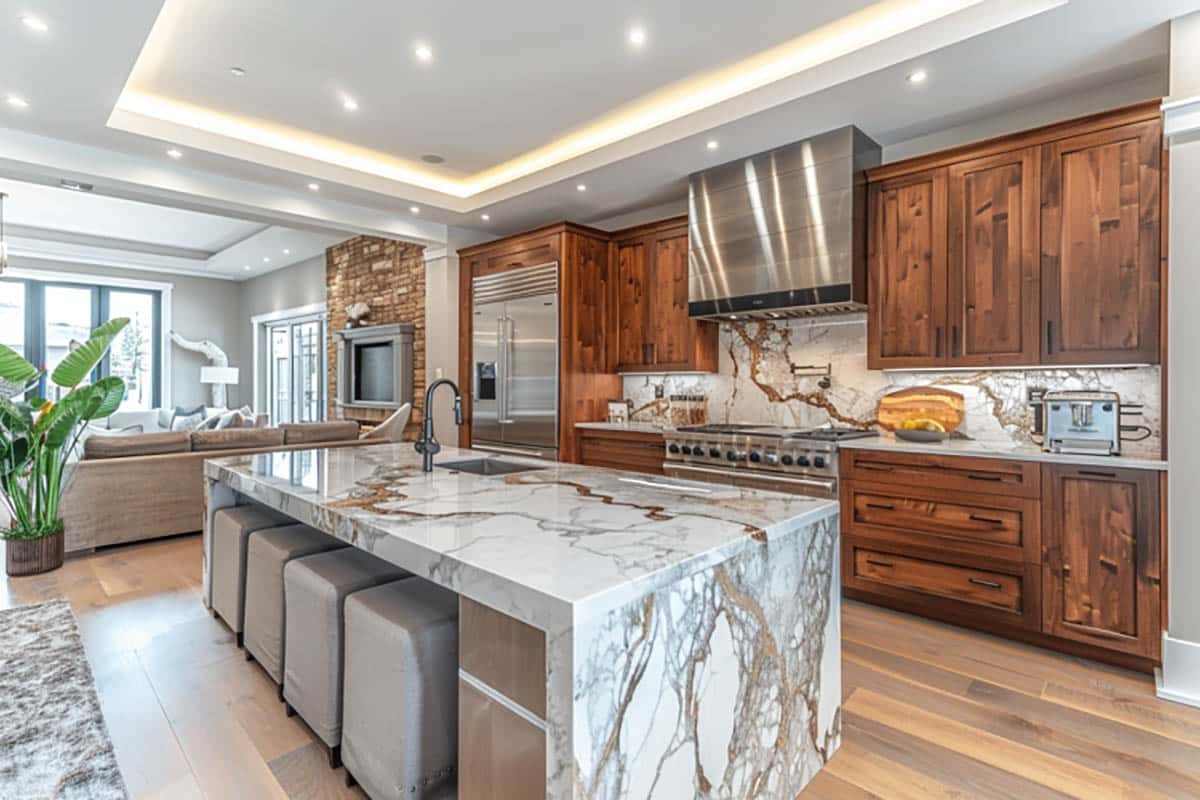
Establishing a kitchen appliance storage method will depend on the availability of storage space such as kitchen cabinetry, pantry, and countertops. We all have different family lifestyles; we have different kitchen appliances that will always be available to use and be the most accessible.
Appliance drawers and appliance storage are two solutions that we highly recommend and ensure that these will offer many benefits, improve safety, and enhance functionality for your kitchen storage space.
Appliance drawers are more common storage solutions that usually require drawers to fully extend providing better storage & accessibility to small appliances or pots and pans. Adding drawer dividers to organize utensils, gadgets, and small kitchen tools and help keep them neatly separated to prevent clutter.
On the other hand, there are also storage solutions that are integrated with the kitchen cabinetry which have similar functions as appliance drawers but they are built larger and have deeper depth to accommodate bulkier appliances such as food processors, stand mixers, and slow cookers.
Under-cabinet storage racks can also be installed in unused space beneath the hanging cabinets for storing spices, and coffee mugs, or a space to hang baskets for fruits and vegetables. Under-sink organizers such as pull-out trays and sliding baskets can make the cabinet space beneath the sink useful. Lazy Susans are best integrated with corner cabinets to make the best use of their rotating shelves for easy access & maximum storage capacity.
Vertical shelf dividers integrated into kitchen cabinets allow you to organize plates, baking pans, cutting boards, or cooking lids for pots and can maximize space in your cabinetry. Adjustable shelf risers can also help maximize vertical storage space by accommodating different heights of appliances.
All these storage solutions are great ideas to make the most of your kitchen space which ensures that small appliances are neatly concealed and gives you the ability to customize your storage spaces.
Understanding Family Needs
As the heart of the home, the kitchen is where the day begins – it is where all the family members talk over delicious meals and hang out – it’s the social hub of the home where family bonding takes place because food and conversation go perfectly together. As an interior designer, I believe that the real value of the kitchen lies in planning a layout that can adapt to all the family’s needs. It is essential to consider practicality and functionality with the aesthetics of the place carefully.
One of the things that needs to be considered thoroughly is the workflow that happens in the kitchen. The location of your major kitchen appliances should blend in seamlessly with your working area. Having direct access to items you mostly use and having the space to work in your kitchen will enable you to prepare and cook meals with the least waste of time and effort.
A family kitchen is more than just a place for cooking meals, it is where the true heart of the home can be found, where the children fix their snacks or a parent organizes meals and activities. These are just a few reasons why the family kitchen must be adaptable enough to work for the homeowner’s lifestyle.

